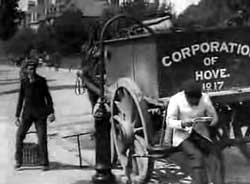 At about five & three-quarter minutes, Our New Errand Boy (1905) is a substantial little silent film from the pioneering days of cinema.
At about five & three-quarter minutes, Our New Errand Boy (1905) is a substantial little silent film from the pioneering days of cinema.
It's an example of one of the early popular genres, the "bad boys" genre. Frequently such lads experience no punishment or come-uppance.
Newly hired & unproven, the titular errand boy is introduced out in front of a general store at Hove, already just messing around until the owner gives him a push-broom which he puts to use, not without complaint.
He's then sent on an errand & uses the opportunity to play a trick on a pedestrian before rushing back to the store & taking up the broom as innocently as he could.
On another errand he gets together with a fellow mischief-maker & plays more practical jokes on other unsuspecting men & women.
At some point he's annoyed so many people that they gather at the general store to await his return. When he shows up, he realizes the jig is up, & he takes off running.
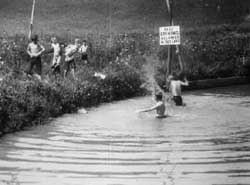 A chase sequence results, the lad getting the better of the adults along the way, including hosing them down as they try to get over a high fence. A chase sequence results, the lad getting the better of the adults along the way, including hosing them down as they try to get over a high fence.
Sometimes unpunished "bad" boys really oughtn't be encouraged, but in other cases, disobeying the rules is the required thing, so of course no come-uppance is required.
Under a sign that reads "No Bathing Allowed in this Lake," two boys are happily splashing in their shorts, in the short-short Turning the Tables (1903), filmed at an actual "swimming hole" in Wilmington, Deleware.
Five more boys arrive on the scene & strip to their civies to leap in ye olde swimming hole. Then a policeman who is a precursor to one of the Keystone Cops arrives on the scene to harrass the happily swimming boys. The big joke is they push him in the pond which gives them time to grab their clothes & hightail it away.
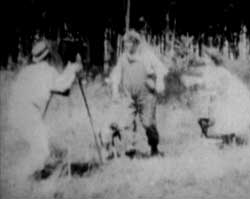 A minute's worth of a comedy film, Photographing a Country Couple (1901) begins with a photographer walking through a woodsy environment.
A minute's worth of a comedy film, Photographing a Country Couple (1901) begins with a photographer walking through a woodsy environment.
Finding a park bench, & setting up his tripod, he calls to a nearby couple to sit on the bench, their dog following along.
The attractive young lady has a homely rube of a boyfriend, who has a bad habit of slapping his girlfriend with his hat.
The photographer lets the easily impressed rube look through the camera lens while taking the boyfriend's place on the park bench, pitching woo to the gal.
A standard "bad boy" character sneaks into the picture frame & with twine ties the rube's legs to two legs of the tripod.
When the rube sees through the aperature that the photographer is getting it on with his gal, he tries to walk toward the bench, with the tripod legs & camera moving with him.
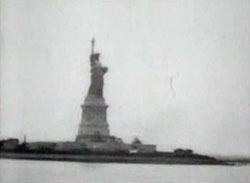 A view from a boat of the Statue of Liberty (1898) on Bedlowe's Island is a minimalist actuality film.
A view from a boat of the Statue of Liberty (1898) on Bedlowe's Island is a minimalist actuality film.
There is hardly any motion to it, other than the rocking of the boat, so the camera is neither moving closer nor panning past the landmark. So it's about as uninteresting as the least of the actualities ever get.
But as a historical point of interest, it's thought likely to be the first moving picture of the statue, even though "moving" is a stretch.
Miners Leaving Pendlebury Colliery (1901) shows strong men, but alas also some very young boys, heading home (or to a pub) after a day's labor in an English coal pit.
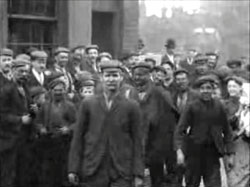 Amidst the men is a black miner, which is nice to see. The black laborer appears to be taken for granted & just one of the guys, not unlike how Paul Robeson played the role in The Proud Valley (1940). Amidst the men is a black miner, which is nice to see. The black laborer appears to be taken for granted & just one of the guys, not unlike how Paul Robeson played the role in The Proud Valley (1940).
At one point the miners stop passing by the camera & begin to gather in front of it. One fellow squares his shoulder & moves toward the camera with the gaze of territorial imperative.
There's a woman in the shot; & a guy in the background has a dressy bowler hat instead of the porkpie caps of the majority. Some of these figures are not workers but ordinary pedestrians or people who showed up to see the camera.
Then the crowd of workers is back in motion. There suddenly appears a raggedy-dressed man with an advertising signboard that reads in part "Living Pictures, Passion Play," but no one takes notice of him, they find the camera more interesting.
Two smartly boys stand side by side in a posture that denotes their desire to be photographed as cocky fellas. The minute & a half film ends with the appearance on the street of a one-horse wagon.
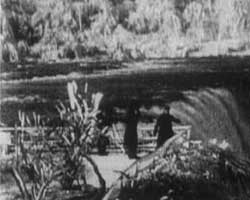 Because much of the water on its way to Niagara Falls is nowadays siphoned away for sundry human uses, its shocking awesomeness has alas become something that can only be comprehended through vintage films.
Because much of the water on its way to Niagara Falls is nowadays siphoned away for sundry human uses, its shocking awesomeness has alas become something that can only be comprehended through vintage films.
American Falls from Above, American Side (1896) is a very pictorial view of the Falls & Goat Island, with tourists pointing & appreciating the view.
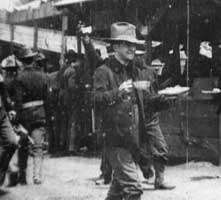 The film was part of the Edison company's "New Niagara Falls Series," a popular travel subject. The film was part of the Edison company's "New Niagara Falls Series," a popular travel subject.
Filmed on location with the New York State Militia at their training camp in Peekskill, militia men are shown outdoors getting their meals from a shed in Mess Call (1896).
These men are very curious about the camera & mugging & acting up for the photographer, as people realizing they're being filmed would be doing throughout the coming century.
Though primarily an "actuality film" which were what such documentary fragments were called in their day, it also passes as an "Expression Film" for the wonderful faces the men are making.
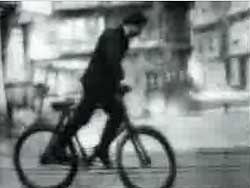 A half-minute Edison film Bicycle Trick Riding No. 2 (1899) shows a man riding his bicycle rapidly backwards in a circle.
A half-minute Edison film Bicycle Trick Riding No. 2 (1899) shows a man riding his bicycle rapidly backwards in a circle.
The rider begins twirling the handlebars & front wheel as he rides forward, then climbs over the handlebars to ride in front without slowing down.
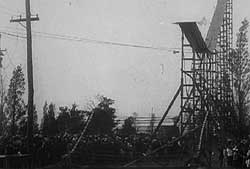 The rider was identified in the Edison catalog only as "Neidert," a nationally famed trick rider. The rider was identified in the Edison catalog only as "Neidert," a nationally famed trick rider.
A much more startling stunt is preserved in the short-short High Diving Scene (1901) featuring a bycyclist racing down a bicycle's version of a ski-jump, straight into the air.
The bicycle coming down in a pool of water, with an enormous crowd surrounding the pool to watch. The cyclist climbs out of the water onto a little stage & bows first to the camera, then to the audience.
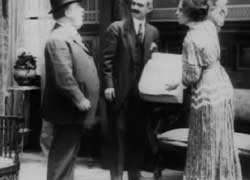 Ashley Miller directed commedian John R. Cumpson in a series of "Mr. Bumptious" comedies.
Ashley Miller directed commedian John R. Cumpson in a series of "Mr. Bumptious" comedies.
In the four-minute short How Bumptious Papered the Parlor (1910), a salesman is showing Mrs. Bumptious wallpaper choices. Her tubby husband comes in to get the estimate of cost for installation.
The price causes him to insist he can do it himself. With his potbelly & his bowler hat worn indoors, we pretty much automatically expect an Oliver Hardy fiasco to arise from that cheapskate motivation.
He heads down to a discount wallpaper shop & buys some scraps. He's such a clutz that it all gets torn up before he even arrives home. Then there's the matter of mixing the flour paste. Lastly is the hideously inept attempt to cover the whole wall including plate rails & wainscotting with poorly affixed paper, a complete mess.
A mite obvious throughout with no effective gags whatsoever, except the close with Mr. Bumptious in his easy chair watching the professional paperhanger doing the job right.
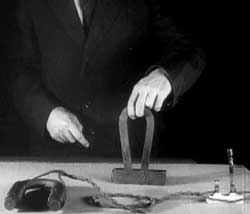 A science documentary about magnetism running to eight minutes, The Wonders of Magnetism (1915) is a very straightforward exhibition of the powers of magnets.
A science documentary about magnetism running to eight minutes, The Wonders of Magnetism (1915) is a very straightforward exhibition of the powers of magnets.
We're shown how multiple magnets multiply in strength; use of metal particles to show the magnetic fields; how to manipulate the fields; how the poles attract or repell, with several simple experiments that could be duplicated in gradeschools.
The stuff with magnets arranging themselves in patterns when floated on water was actually pretty cool. I don't remember doing that one in grade school, but perhaps my aging memory has lost a few connections.
The comparison between weak normal magnets & powerful electric magnets is pure Edison Company self-aggrandizement but it's successfully educational even so. The huge electro-magnet & the bucket of nails would've impressed the hell out of me when I was a kid.
copyright © by Paghat the Ratgirl
|


 A chase sequence results, the lad getting the better of the adults along the way, including hosing them down as they try to get over a high fence.
A chase sequence results, the lad getting the better of the adults along the way, including hosing them down as they try to get over a high fence.

 Amidst the men is a black miner, which is nice to see. The black laborer appears to be taken for granted & just one of the guys, not unlike how Paul Robeson played the role in The Proud Valley (1940).
Amidst the men is a black miner, which is nice to see. The black laborer appears to be taken for granted & just one of the guys, not unlike how Paul Robeson played the role in The Proud Valley (1940).
 The film was part of the Edison company's "New Niagara Falls Series," a popular travel subject.
The film was part of the Edison company's "New Niagara Falls Series," a popular travel subject.
 The rider was identified in the Edison catalog only as "Neidert," a nationally famed trick rider.
The rider was identified in the Edison catalog only as "Neidert," a nationally famed trick rider.
